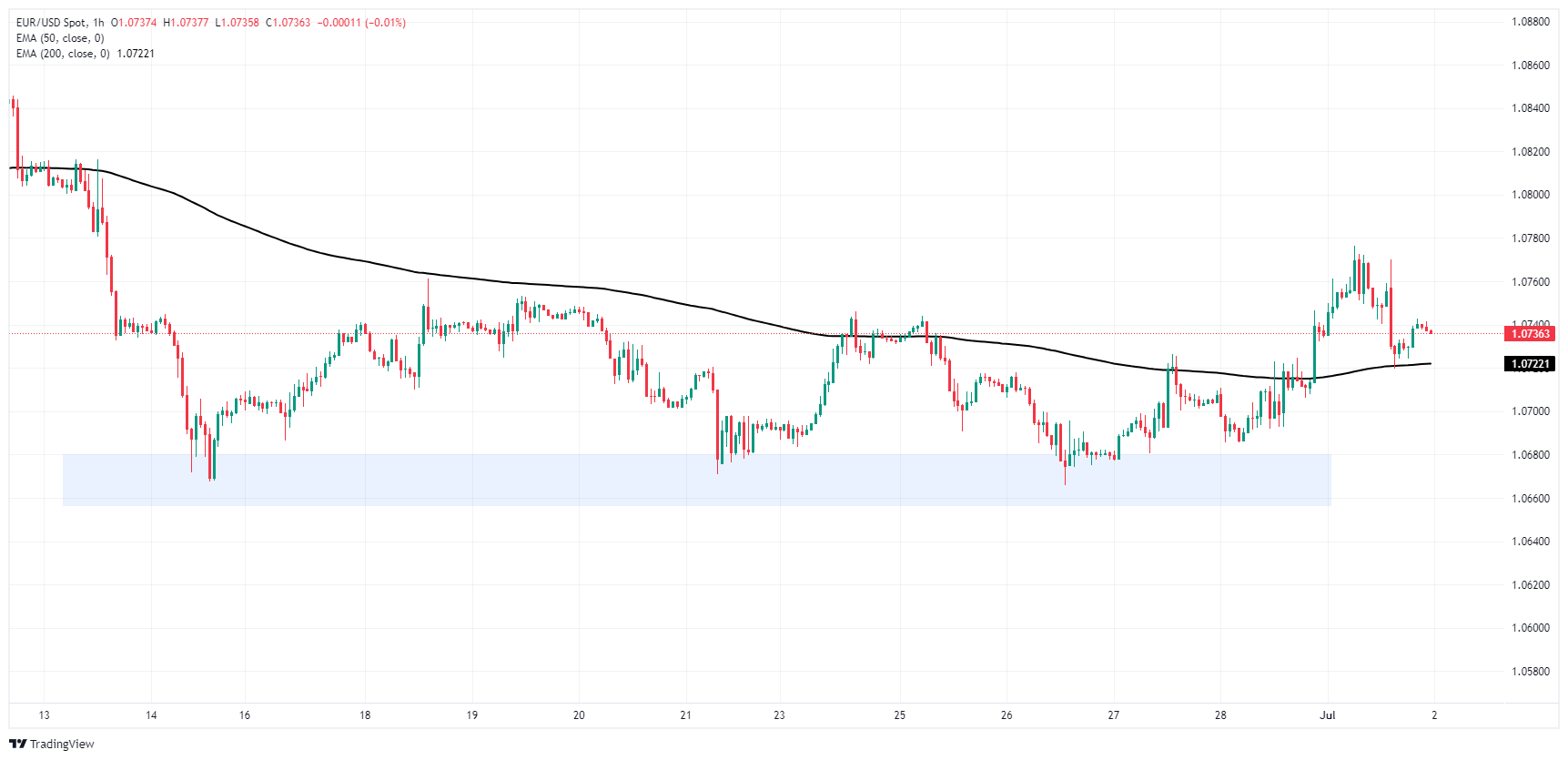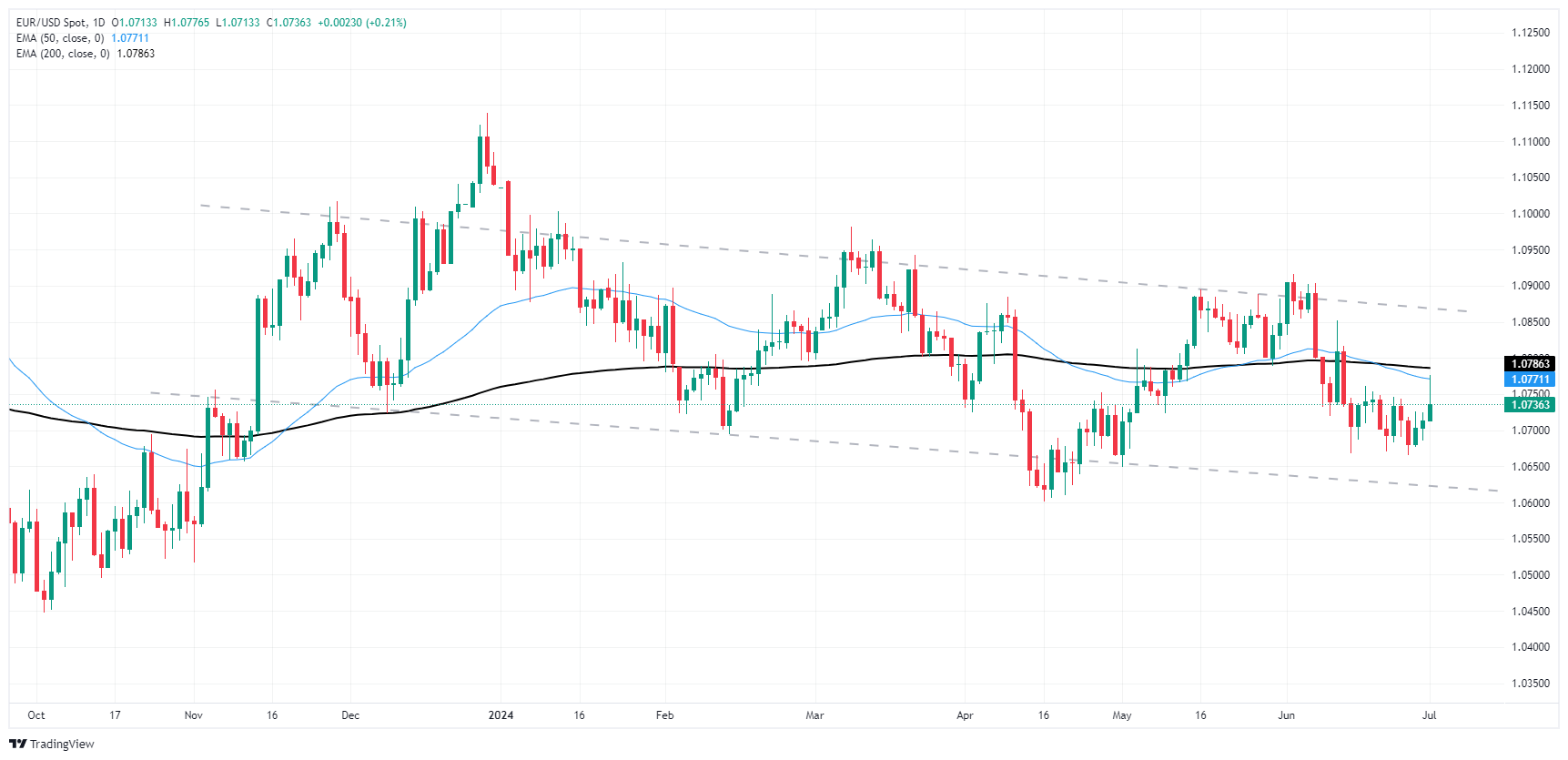- Phân tích
- Tin tức và các công cụ
- Tin tức thị trường
- EUR/USD looks higher on Monday but technical ceiling remains
EUR/USD looks higher on Monday but technical ceiling remains
- EUR/USD briefly tested above 1.0770 on Monday before settling back.
- A packed economic data docket awaits the Fiber this week.
- EU HICP inflation, US NFP data looms ahead.
EUR/USD clipped into a fresh multi-week high above 1.0770 on Monday before getting forced back down by a broad-market reversal in investor sentiment. Bullish momentum was cut short after US activity figures flashed warning signs of a steepening economic downturn. Investors will be buckling down for the wait to key economic figures on both sides of the Atlantic throughout the week, culminating in a fresh print of US Nonfarm Payrolls (NFP) slated for Friday.
Forex Today: All the attention shifts to Powell and Lagarde
German Consumer Price Index (CPI) figures broadly missed the mark early Monday, with annualized German CPI easing to 2.2% in June, falling from the previous 2.4% and backsliding through the forecast 2.3%. US data also missed expectations on Monday; US ISM Manufacturing Purchasing Manager Index (PMI) figures declined in June, falling to 48.5 from 48.7 and entirely missing the forecast increase to 49.1. US ISM Manufacturing Prices Paid also declined sharply in June, falling to 52.1 from the previous 57.0, falling even further beyond the forecast decline to 55.9.
Economic Indicator
ISM Manufacturing PMI
The Institute for Supply Management (ISM) Manufacturing Purchasing Managers Index (PMI), released on a monthly basis, is a leading indicator gauging business activity in the US manufacturing sector. The indicator is obtained from a survey of manufacturing supply executives based on information they have collected within their respective organizations. Survey responses reflect the change, if any, in the current month compared to the previous month. A reading above 50 indicates that the manufacturing economy is generally expanding, a bullish sign for the US Dollar (USD). A reading below 50 signals that factory activity is generally declining, which is seen as bearish for USD.
Read more.Last release: Mon Jul 01, 2024 14:00
Frequency: Monthly
Actual: 48.5
Consensus: 49.1
Previous: 48.7
Source: Institute for Supply Management
The Institute for Supply Management’s (ISM) Manufacturing Purchasing Managers Index (PMI) provides a reliable outlook on the state of the US manufacturing sector. A reading above 50 suggests that the business activity expanded during the survey period and vice versa. PMIs are considered to be leading indicators and could signal a shift in the economic cycle. Stronger-than-expected prints usually have a positive impact on the USD. In addition to the headline PMI, the Employment Index and the Prices Paid Index numbers are watched closely as they shine a light on the labour market and inflation.
US markets were abruptly jolted into fresh risk concerns over the upcoming November presidential election. A recent public debate left the waters murky on who the clear frontrunner would be, and the US Supreme Court released a ruling on Monday stating that courts have limited capacity to levy criminal charges against sitting Presidents.
A fresh batch of key European data will drop on markets on Tuesday, with a slate of speeches from European Central Bank (ECB) policymakers including another appearance from ECB President Christine Lagarde. Pan-European Harmonized Index of Consumer Prices (HICP) inflation is expected to tick down slightly, with Core EU HICP inflation forecast to tick down to 2.8% YoY from the previous 2.9%. European Producer Price Index (PPI) inflation data is due Wednesday, followed by EU-wide Retail Sales figures early Friday.
On the US side, investors will be looking ahead to Tuesday’s appearance from Federal Reserve (Fed) Chairman Jerome Powell, followed by ADP Employment Change figures on Wednesday and Friday’s latest iteration of US Nonfarm Payrolls (NFP) and Average Hourly Earnings for June.
Euro PRICE This week
The table below shows the percentage change of Euro (EUR) against listed major currencies this week. Euro was the strongest against the New Zealand Dollar.
| USD | EUR | GBP | JPY | CAD | AUD | NZD | CHF | |
|---|---|---|---|---|---|---|---|---|
| USD | 0.04% | 0.03% | -0.02% | 0.02% | 0.09% | 0.16% | 0.06% | |
| EUR | -0.04% | -0.01% | -0.05% | -0.02% | 0.06% | 0.11% | 0.02% | |
| GBP | -0.03% | 0.00% | -0.04% | -0.00% | 0.04% | 0.11% | 0.02% | |
| JPY | 0.02% | 0.05% | 0.04% | 0.03% | 0.13% | 0.15% | 0.07% | |
| CAD | -0.02% | 0.02% | 0.00% | -0.03% | 0.08% | 0.13% | 0.04% | |
| AUD | -0.09% | -0.06% | -0.04% | -0.13% | -0.08% | 0.05% | -0.04% | |
| NZD | -0.16% | -0.11% | -0.11% | -0.15% | -0.13% | -0.05% | -0.09% | |
| CHF | -0.06% | -0.02% | -0.02% | -0.07% | -0.04% | 0.04% | 0.09% |
The heat map shows percentage changes of major currencies against each other. The base currency is picked from the left column, while the quote currency is picked from the top row. For example, if you pick the Euro from the left column and move along the horizontal line to the US Dollar, the percentage change displayed in the box will represent EUR (base)/USD (quote).
EUR/USD technical outlook
The Fiber kicked off the new trading week with a fresh push into 12-day peaks above 1.0770 before crumpling risk appetite dragged the pair back down to 1.0735. Intraday price action continues to lean into the midrange as EUR/USD grapples with the 200-hour Exponential Moving Average (EMA) at 1.0722.
EUR/USD found technical support from a demand zone priced in below 1.0680, but bullish momentum remains limited as technical indicators weigh bids down. Daily candlesticks remain pinned below the 200-day EMA at 1.0786, and Fiber remains trapped on the low end of a recent decline from June’s early bids above 1.0900.
EUR/USD hourly chart
EUR/USD daily chart
Euro FAQs
The Euro is the currency for the 20 European Union countries that belong to the Eurozone. It is the second most heavily traded currency in the world behind the US Dollar. In 2022, it accounted for 31% of all foreign exchange transactions, with an average daily turnover of over $2.2 trillion a day. EUR/USD is the most heavily traded currency pair in the world, accounting for an estimated 30% off all transactions, followed by EUR/JPY (4%), EUR/GBP (3%) and EUR/AUD (2%).
The European Central Bank (ECB) in Frankfurt, Germany, is the reserve bank for the Eurozone. The ECB sets interest rates and manages monetary policy. The ECB’s primary mandate is to maintain price stability, which means either controlling inflation or stimulating growth. Its primary tool is the raising or lowering of interest rates. Relatively high interest rates – or the expectation of higher rates – will usually benefit the Euro and vice versa. The ECB Governing Council makes monetary policy decisions at meetings held eight times a year. Decisions are made by heads of the Eurozone national banks and six permanent members, including the President of the ECB, Christine Lagarde.
Eurozone inflation data, measured by the Harmonized Index of Consumer Prices (HICP), is an important econometric for the Euro. If inflation rises more than expected, especially if above the ECB’s 2% target, it obliges the ECB to raise interest rates to bring it back under control. Relatively high interest rates compared to its counterparts will usually benefit the Euro, as it makes the region more attractive as a place for global investors to park their money.
Data releases gauge the health of the economy and can impact on the Euro. Indicators such as GDP, Manufacturing and Services PMIs, employment, and consumer sentiment surveys can all influence the direction of the single currency. A strong economy is good for the Euro. Not only does it attract more foreign investment but it may encourage the ECB to put up interest rates, which will directly strengthen the Euro. Otherwise, if economic data is weak, the Euro is likely to fall. Economic data for the four largest economies in the euro area (Germany, France, Italy and Spain) are especially significant, as they account for 75% of the Eurozone’s economy.
Another significant data release for the Euro is the Trade Balance. This indicator measures the difference between what a country earns from its exports and what it spends on imports over a given period. If a country produces highly sought after exports then its currency will gain in value purely from the extra demand created from foreign buyers seeking to purchase these goods. Therefore, a positive net Trade Balance strengthens a currency and vice versa for a negative balance.
© 2000-2024. Bản quyền Teletrade.
Trang web này được quản lý bởi Teletrade D.J. LLC 2351 LLC 2022 (Euro House, Richmond Hill Road, Kingstown, VC0100, St. Vincent and the Grenadines).
Thông tin trên trang web không phải là cơ sở để đưa ra quyết định đầu tư và chỉ được cung cấp cho mục đích làm quen.
Giao dịch trên thị trường tài chính (đặc biệt là giao dịch sử dụng các công cụ biên) mở ra những cơ hội lớn và tạo điều kiện cho các nhà đầu tư sẵn sàng mạo hiểm để thu lợi nhuận, tuy nhiên nó mang trong mình nguy cơ rủi ro khá cao. Chính vì vậy trước khi tiến hành giao dịch cần phải xem xét mọi mặt vấn đề chấp nhận tiến hành giao dịch cụ thể xét theo quan điểm của nguồn lực tài chính sẵn có và mức độ am hiểu thị trường tài chính.
Sử dụng thông tin: sử dụng toàn bộ hay riêng biệt các dữ liệu trên trang web của công ty TeleTrade như một nguồn cung cấp thông tin nhất định. Việc sử dụng tư liệu từ trang web cần kèm theo liên kết đến trang teletrade.vn. Việc tự động thu thập số liệu cũng như thông tin từ trang web TeleTrade đều không được phép.
Xin vui lòng liên hệ với pr@teletrade.global nếu có câu hỏi.















